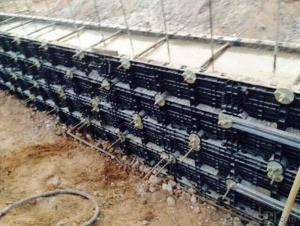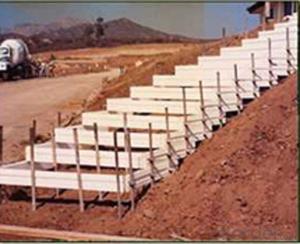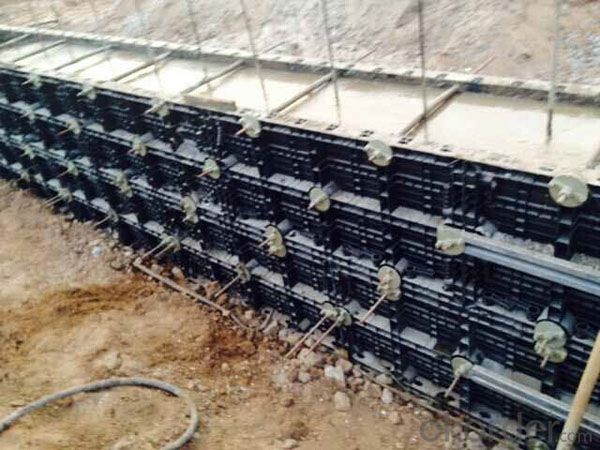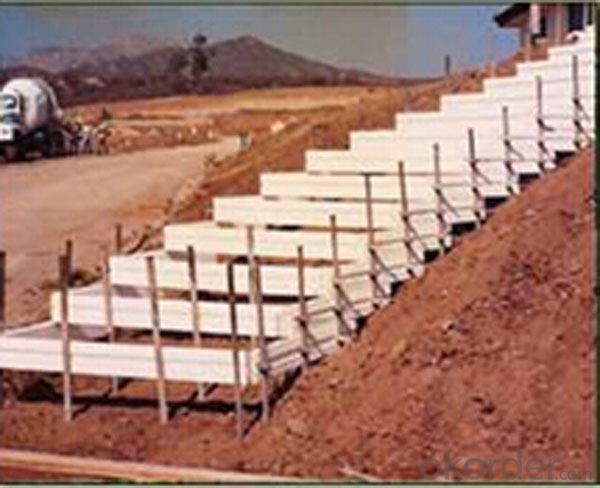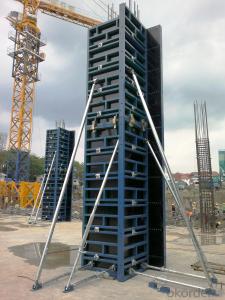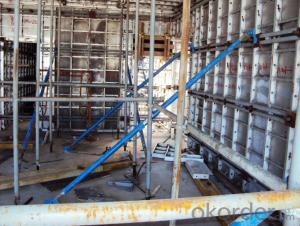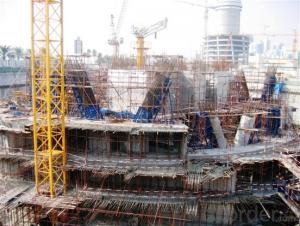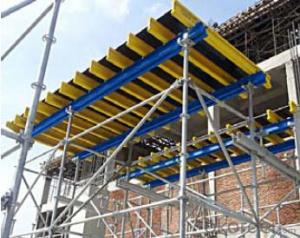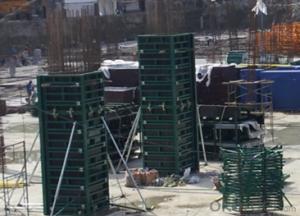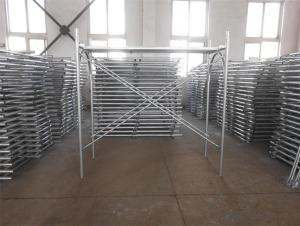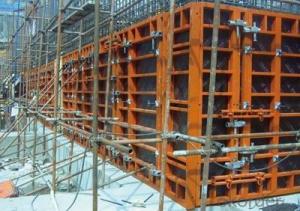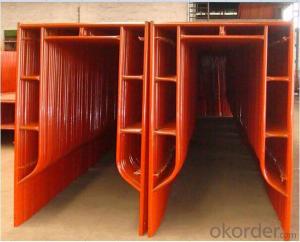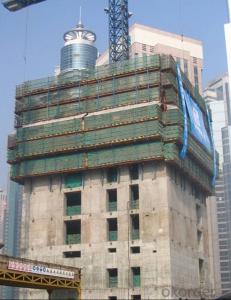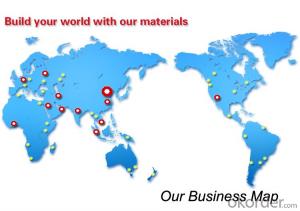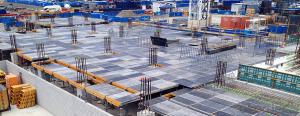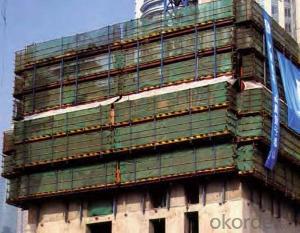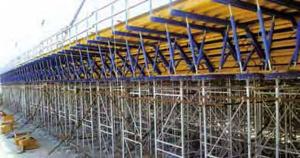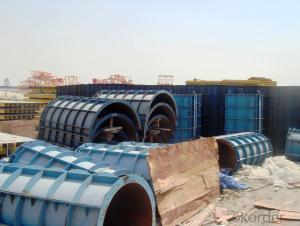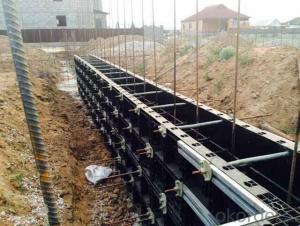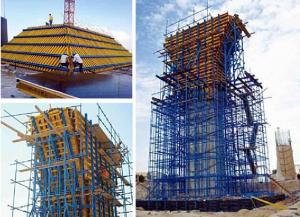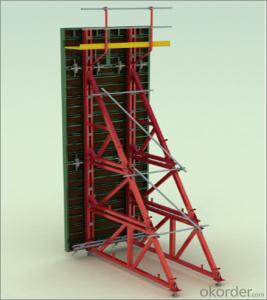Galvanized Scaffolding Tube Formwork Galvanized Scaffolding Tube With Low Price
- Loading Port:
- Tianjin
- Payment Terms:
- TT OR LC
- Min Order Qty:
- 10000 set
- Supply Capability:
- 50000 set/month
OKorder Service Pledge
OKorder Financial Service
You Might Also Like
Galvanized Scaffolding Tube Formwork Galvanized Scaffolding Tube With Low Price
Circular Column Formwork Outrigger For Scaffolding
Developing with new technology materials, steel formworks is no longer a must in construction concrete process. More and more buildings are established with plastic formworks. And workers love this new formworks much more.
The advantages of plastic formworks:
1.First of all--light
Yes it is the first advantage of plastic formwork. It wins the great praise of both contractors and workers.
The biggest panel is 120×1500px,weights 10.5kg only. It can be lift and set up by one person easily, which means there is no need for cranes on site.Saves a lot of cost and time.
2.Easy set up
Different size of panels can firmly locked by simply turn the special handles to 90 degree. The Panels has rib on the back, which makes the system need not traditional wood blocks and nails. The panels have holes to fit tie rod, guarantee the strength of the whole system.
4.Strength
The handles are made by high strength Nilon, each panel locked by at least 4 handles, which makes the whole system strong enough to pour 1000px walls.
5.Environment friendly
The system needs no cut and nail due to the variety size. Also it needs nearly no wood. The material can be recycled after broken, so it will not pollute the environment.
6.Consequent
Concrete does not stick to plastic formwork, thus the panels need no oil before using, and can be cleaned simply by water. The surface of the wall which build by modular formwork is smooth and without rework.
Galvanized Scaffolding Tube Formwork Galvanized Scaffolding Tube With Low Price
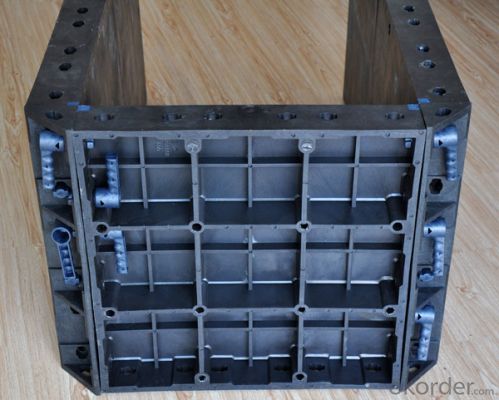
Galvanized Scaffolding Tube Formwork Galvanized Scaffolding Tube With Low Price
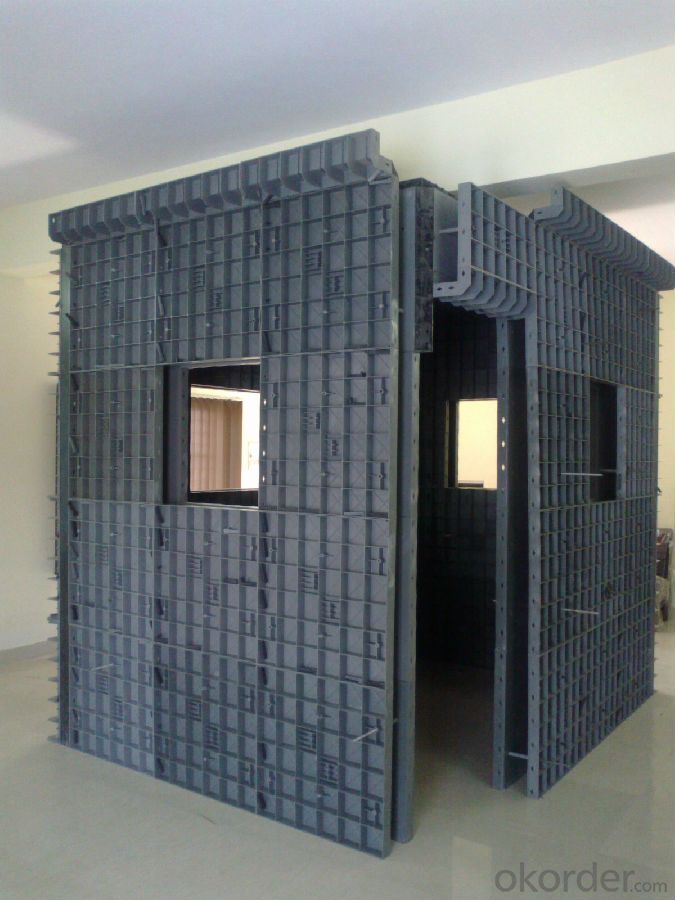
Galvanized Scaffolding Tube Formwork Galvanized Scaffolding Tube With Low Price
Advantage
* Good loading capacity
* Easy to assemble and dismantle
* Stable and durable thanks to its structual design & automatic welding quality
* Customized solution helps you work safe, save cost and convenient
* Excellent quality for formwork & scaffolding
Packing
in bulk or in bundle, or as requested
Shipping
15-20 Days.
Normally small orders, it needs just 15-20 business days to the port.
Galvanized Scaffolding Tube Formwork Galvanized Scaffolding Tube With Low Price
Other scaffolding & formwork products:
(1) Scaffolding System:
Including Ringlock Scaffolding System and accessories; Cuplock Scaffolding System and accessories; Kwikstage Scaffolding System and accessories; Haki Scaffolding System and accessories;
(2) Scaffolding Frame & Accessories:
Including Walk Through Frame Scaffolding; Ladder Frame Scaffolding; Accessories; we also can make scaffolding according to your samples or drawings.
(3) Scaffolding Couplers/Clamps:
We can produce all kinds of forged and pressed couplers, including British type couplers, American type couplers, German type couplers, Italian type couplers ,fence couplers, BRC coplers and so on. We also can produce according to your drawings or samples.
(4) Formwork System Scaffolding & Accessories:
Light Duty Shoring prop and Heavy Duty Shoring Prop; Wing nuts and Tie rods; RASTO clamp and so on.
FAQ Galvanized Scaffolding Tube Formwork Galvanized Scaffolding Tube With Low Price
Why Us?
We are one of the Top 500 in the world, largest construction materials supplier in China. Also we are a state-owned company and respond to every customer with large and also small orders.
We own professional manufacturers with powerful producing capacity.
Extensive and comprehensive quality control system
Full energy with affluent experience team.
- Q: What are the different types of connections used with steel frame formwork?
- There are several types of connections used with steel frame formwork, each serving a specific purpose and offering different advantages. Some of the most commonly used connections include: 1. Wedge connections: These are simple and quick connections that involve inserting a wedge into a slot to secure the formwork panels together. They provide good stability and are easy to assemble and disassemble. 2. Pin and wedge connections: This type of connection involves inserting a pin into a hole in the formwork panel and securing it with a wedge. It provides a strong connection and is commonly used for larger formwork systems. 3. Bolted connections: Bolted connections involve using bolts and nuts to connect the formwork panels together. This type of connection offers excellent stability and strength, making it suitable for heavy-duty applications. 4. Clip-on connections: Clip-on connections use spring-loaded clips to connect the formwork panels. They are quick and easy to use, allowing for fast assembly and disassembly of the formwork system. 5. Hinged connections: Hinged connections involve using hinges to connect the formwork panels. This type of connection allows for flexibility and adjustability, making it suitable for curved or irregularly shaped structures. 6. Magnetic connections: Magnetic connections use magnets to hold the formwork panels together. This type of connection is convenient and eliminates the need for additional tools or hardware. Overall, the choice of connection type depends on factors such as the size and complexity of the formwork system, the required strength and stability, and the ease of assembly and disassembly.
- Q: Are there any restrictions on the tolerance levels that can be achieved with steel frame formwork?
- Yes, there are restrictions on the tolerance levels that can be achieved with steel frame formwork. The accuracy of the formwork assembly, the quality of the steel used, and the precision of the construction techniques employed all play a role in determining the achievable tolerance levels. Additionally, factors such as the size and complexity of the structure being built also impact the level of tolerance that can be achieved.
- Q: Can steel frame formwork be used for both large and small construction projects?
- Yes, steel frame formwork can be used for both large and small construction projects. Steel frame formwork is a versatile and durable solution that can be easily customized to fit various project sizes and requirements. It provides a strong and stable framework for pouring concrete, ensuring accuracy and precision in construction. Whether it is a small residential building or a large commercial complex, steel frame formwork can be adjusted and assembled accordingly to create the desired shape and structure. Additionally, steel frame formwork is reusable, making it a cost-effective option for both small and large-scale projects. Its versatility, strength, and reusability make it a suitable choice for construction projects of all sizes.
- Q: Can steel frame formwork be used for circular columns?
- Yes, steel frame formwork can be used for circular columns. It is flexible and adjustable, allowing it to be easily adapted to the desired shape and size of circular columns.
- Q: How does steel frame formwork contribute to better concrete curing in different weather conditions?
- In various weather conditions, steel frame formwork has the ability to enhance the curing of concrete through different means. To begin with, one way in which steel frame formwork can improve the concrete curing process is by offering exceptional protection and insulation. Acting as a barrier against harsh weather elements like rain, snow, extreme heat, and cold, it shields the concrete from potential damage during the vulnerable initial stages of curing. Furthermore, steel frame formwork provides stability and rigidity to the concrete structure, preventing any deformation or displacement that may be caused by weather-related factors such as wind or temperature fluctuations. This ensures that the concrete retains its intended shape and strength throughout the curing process. In addition, steel frame formwork allows for effective control over the curing environment. By enabling the construction team to regulate temperature and humidity levels within the formwork, it creates optimal conditions for the concrete to properly cure. This is particularly crucial in challenging weather conditions, where the natural environment may not be conducive to ideal curing conditions. Moreover, steel frame formwork offers a secure and durable enclosure for the concrete, safeguarding it from potential damage caused by moisture, frost, or rapid changes in temperature. This helps minimize the risk of cracks or other defects in the cured concrete, ensuring its long-term structural integrity. Lastly, steel frame formwork facilitates easier and more accurate monitoring of the concrete curing process. By providing clear access points and visibility, it allows construction professionals to regularly inspect and evaluate the progress of the concrete. This enables timely adjustments or interventions, ensuring that the curing process stays on track regardless of the weather conditions. In conclusion, steel frame formwork plays a crucial role in enhancing the curing of concrete in various weather conditions. By providing protection, stability, control, and monitoring capabilities, it contributes to the successful and high-quality curing of concrete, regardless of the challenges posed by the environment.
- Q: Can steel frame formwork be used in areas with high humidity or moisture content?
- Yes, steel frame formwork can be used in areas with high humidity or moisture content. Steel is highly resistant to corrosion and can withstand harsh environmental conditions, making it suitable for use in such areas.
- Q: How does steel frame formwork handle the load distribution of a structure?
- A versatile and strong system utilized in construction for effective load distribution of structures is steel frame formwork. The main characteristic of this formwork is its ability to evenly distribute weight and forces on the structure, ensuring a stable and balanced load distribution. To begin with, steel frame formwork is comprised of interconnected rigid and strong steel panels capable of withstanding heavy loads. These panels are assembled and fixed together to create a framework that serves as a support system for the structure. The design of the steel frame formwork is such that it evenly distributes the load across the panels, preventing concentration of forces in specific areas. Moreover, steel frame formwork offers high customization, allowing for precise adjustment and alignment of the panels. This adaptability enables the formwork system to accommodate structures with complex geometries or irregular shapes. By ensuring accurate alignment of the panels, the load distribution is optimized, avoiding localized stress points and ensuring a uniform distribution of forces. Furthermore, steel frame formwork has a high load-bearing capacity due to the strength and durability of steel. Steel is known for its robustness and resistance to deformation, enabling it to handle heavy loads without compromising the stability of the structure. The use of steel in the formwork system ensures even and efficient load distribution, minimizing the risk of structural failure or collapse. Additionally, steel frame formwork allows for the integration of additional reinforcement elements, such as steel bars or mesh, which further enhance the load distribution capabilities of the structure. These reinforcements provide additional strength and stiffness, ensuring that the load is evenly distributed across the entire formwork system. In conclusion, steel frame formwork is an excellent solution for managing load distribution in structures. Its strength, adaptability, and high load-bearing capacity enable it to evenly distribute weight and forces on the structure, ensuring a stable and balanced load distribution. This guarantees the structural integrity and safety of the building, making steel frame formwork a popular choice in the construction industry.
- Q: What is the meaning of steel frame support structure?What is the support?
- The so-called steel structure is the support, the traditional way of reinforced concrete as a support, the steel structure is the use of H steel as a support
- Q: How does steel frame formwork handle different types of formwork leveling systems?
- Steel frame formwork proves to be a highly adaptable and long-lasting option for a wide range of construction projects, as it is specifically designed to effectively accommodate diverse formwork leveling systems. The steel frame construction offers a sturdy and inflexible framework, capable of withstanding the weight of the concrete and maintaining the desired formwork shape and alignment. One commonly employed formwork leveling system, which is compatible with steel frame formwork, is the adjustable prop system. This system comprises adjustable props that can be extended or retracted in order to achieve the desired formwork level. The steel frame formwork is designed to effortlessly incorporate these adjustable props, furnishing the necessary support and stability to ensure a level and secure formwork structure. Another alternative for formwork leveling, suitable for use with steel frame formwork, is the hydraulic leveling system. This system capitalizes on hydraulic jacks to adjust the formwork level. The integration of hydraulic leveling systems with steel frame formwork is a straightforward process, enabling precise and efficient adjustment of the formwork level. Moreover, steel frame formwork can also be utilized in conjunction with other leveling systems, including screw jacks or leveling wedges. These systems provide flexibility in adjusting the formwork level and can be effortlessly integrated into the steel frame structure. In conclusion, steel frame formwork is compatible with a variety of formwork leveling systems. Its robust structure guarantees stability and support, while its versatility allows for the incorporation of diverse leveling mechanisms. Consequently, steel frame formwork emerges as a dependable choice for accommodating different types of formwork leveling systems in construction projects.
- Q: How does steel frame formwork handle different types of concrete surface finishes?
- Steel frame formwork offers a versatile and adaptable solution for managing various concrete surface finishes. It presents numerous advantages in achieving high-quality results. To start, the smooth and even surface provided by steel frame formwork minimizes imperfections and irregularities in the final concrete finish. The rigid structure of steel ensures stability and prevents any deformations or movement during pouring and curing. Consequently, the desired shape and form of the concrete are maintained, resulting in a consistent surface finish. Furthermore, steel formwork enables the utilization of different form liners, which can be easily attached to the steel frames. These form liners are flexible sheets or molds that are placed inside the formwork to create diverse patterns, textures, or designs on the concrete surface. This allows for the creation of visually appealing finishes such as brick patterns, wood grain textures, or custom designs. Once the concrete has cured, the form liners can be effortlessly removed, leaving behind a well-defined and aesthetically pleasing finish. Moreover, steel formwork exhibits exceptional durability and can withstand the pressure exerted during the concrete pouring process. This is particularly crucial when dealing with special concrete finishes like exposed aggregate or polished concrete. These finishes require great precision and care to prevent dislodging or damaging the aggregates. The support and stability provided by steel formwork significantly reduce the risk of any damage to the desired surface finish. To summarize, steel frame formwork is an excellent choice for managing various concrete surface finishes due to its stability, adaptability, and durability. It allows for the creation of smooth and uniform finishes, as well as the incorporation of different form liners to achieve distinctive and visually appealing designs. By utilizing steel formwork, contractors can consistently and efficiently achieve the desired finish.
Send your message to us
Galvanized Scaffolding Tube Formwork Galvanized Scaffolding Tube With Low Price
- Loading Port:
- Tianjin
- Payment Terms:
- TT OR LC
- Min Order Qty:
- 10000 set
- Supply Capability:
- 50000 set/month
OKorder Service Pledge
OKorder Financial Service
Similar products
Hot products
Hot Searches
Related keywords
